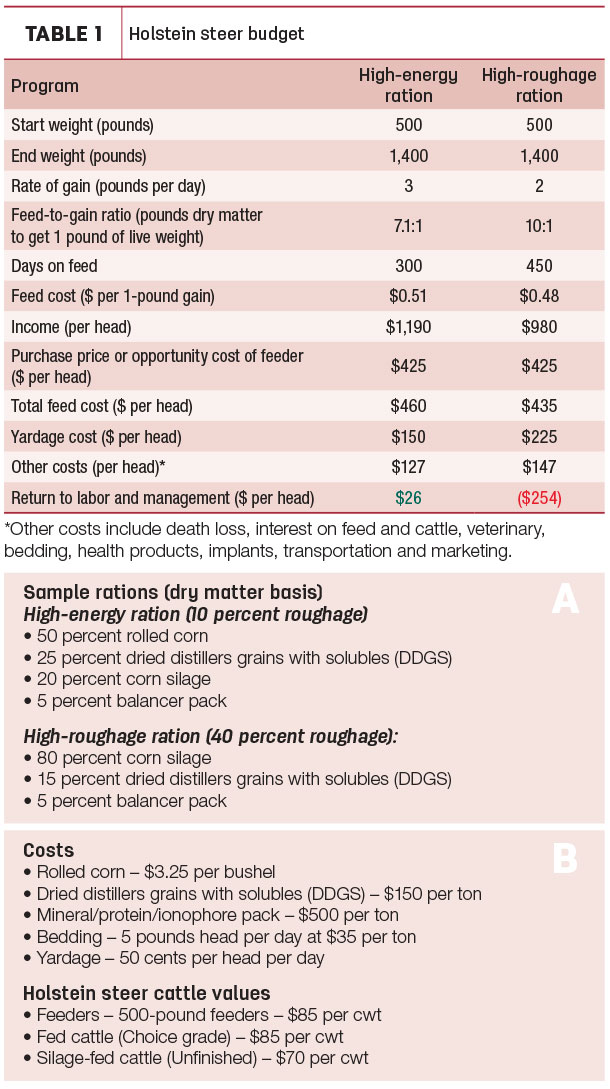These considerations are prompted by low prices for dairy bull calves and the belief that, if someone is willing to pay high prices for the dairy-beef crossbred calves, there must be even more money to be made by feeding them out.
Accurate comparisons must be made to determine if owning these calves longer is the best fit for your operation. It is also a good management practice for producers already raising dairy steers to review their enterprises to see if changes could optimize profits.
Some basic questions that should be answered up-front are:
- Does the operation have enough room for housing the extra animals? Overcrowding is not going to benefit the steers or the replacement heifers, and both will suffer reduced performance. For steers to perform well, they must be kept clean and have places to get out of the wind and wet conditions, especially in the winter.
- Is there adequate labor for the added enterprise? If the operation is already struggling to keep a labor force to handle existing chores, then there may be no need to look further.
- Does the operation have enough feed and acres for applying manure? If either of these is already tight, it may be more challenging.
If there are adequate resources available, it is time to pencil out potential options to determine if owning these animals longer will result in a greater net return than selling them as young calves.
Options to consider are:
- Selling them as 3-day to week-old calves
- Taking them out to weaning or a little further (light feeders)
- Taking them to 800 pounds (heavy feeders)
- Taking them to finish weights
Each option listed above has positives and negatives. For example, if a farm is looking to add some value to forages, they may find backgrounding feeder calves to 800 pounds on a ration that includes forages and balanced so the feeders are gaining 2 to 2.2 pounds a day to be a positive asset to their operation.
To produce highly desirable fed Holsteins, they should be on a finishing ration from about 800 pounds in order to not be too big when they are finished.
Recently, feeding out cattle has resulted in narrow margins: If we look at the last several years, it averages out to about $50 per head net return. When we look at the premium received for dairy-beef crossbred calves at 1 week old, it seems hard to believe a greater premium will be realized after owning the calf until it is feeder weight or a finished animal. The best option will most likely not be the same for all operations.
Enterprise tools available
The University of Wisconsin Extension has enterprise spreadsheet tools available to help evaluate the different dairy steer enterprises to help determine which might be the best option. Visit the UW Extension Beef Information website in the Decision Tools and Software section.
The two spreadsheet tools that will be most helpful are the “Closeout” and “Feedlot enterprise budget” spreadsheets.
The Closeout spreadsheet helps cattle feeders conduct performance and economic analysis of a specific group or pen of steers at a time. There needs to be a definite beginning and end for the group of animals and accurate records of all the related expenses for the group.
The Feedlot enterprise budget spreadsheet is based on a single animal and can help farmers look at various scenarios under different price structures or how changes could influence profitability of feeding out cattle.
Avoid costly discounts
These days, discounts are big for mismanaged cattle at all phases of the feeding process. In addition to the discounts, mismanagement can result in higher costs that are often not readily recognized. Let’s look at one example.
Feeding rations too high in roughage and not high enough in energy is a common management practice. Some farmers are misled into thinking that by feeding the dairy herd’s manger sweepings or poor-quality feeds to steers, they make more money than feeding steers higher-energy growing and finishing rations.
This results in steers that are large-framed but not adequately finished. The high-roughage animal’s carcass is more like a cull cow than a finished animal. These “silage-fed” animals currently are severely discounted when sold.
Let’s look at two scenarios to compare feeding steers on a high-energy ration and a corn silage ration. In both scenarios, we start with 500-pound Holstein feeder calves and will feed them to 1,400 pounds, which should have the high-energy animal grading choice. Prices used are what the UW Extension beef program used for fall of 2018 enterprise projections.
Rations compared
Following is a comparison of the costs and returns for two example feeding programs (Table 1).

We see the high-energy ration has a 3-cent higher cost per pound of gain, resulting in approximately $25 higher cost per head for feed. However, the high-roughage scenario becomes much more expensive because it takes an additional 150 more days on feed to get to 1,400 pounds.
The added yardage costs for facilities, equipment, utilities and extra bedding costs far surpass the small difference in total feed costs in our examples, leading to large losses for the high-roughage ration.
Overhead costs are real but not easy to determine and often underestimated. UW Extension has a Yardage calculator, either as a standalone spreadsheet or also as a component in the Closeout and Feedlot enterprise spreadsheets.
In summary, it is important for dairy producers to evaluate their current operation and potential options for determining how to get the best net return from their dairy and dairy-beef crossbred bull calves. ![]()
Bill Halfman is a ag agent at the University of Wisconsin Extension – Monroe County. Email Bill Halfman.





